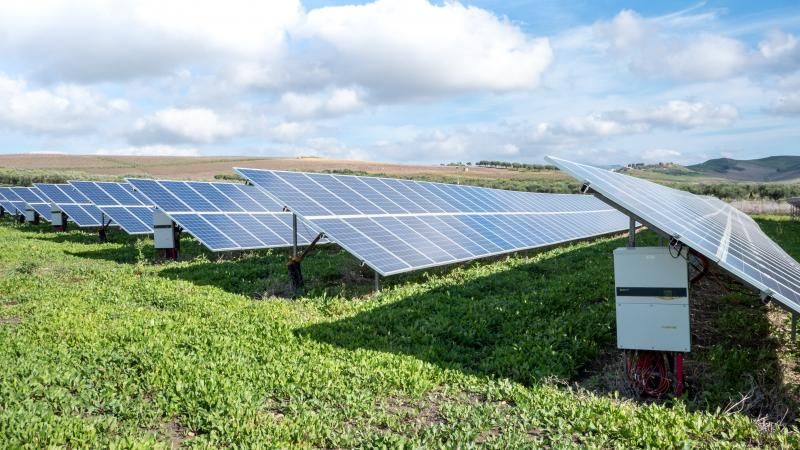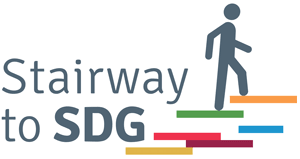Introduction

Photovoltaic PV plant ground mounted with string inverters (By Sungrow EMA on unsplash.com)
As future professionals, VET students should be made aware of the energy systems that are currently used in their field of business. In order to make a sustainable change as a professional, they need to understand which techniques are currently used and how these can be improved, so that they are ready for the future when they enter the labour market and possibly start their own business.
The students are first introduced to the SDG by short videos. After that, they will read to educate themselves why it is important to use sustainable energy.
To be able to really see how which types of energy are currently used in their field of study and thus their future job, the students will conduct an interview with someone who works for a company that is active in the sector of their study field. Thanks to this approach, the student will get important real life insights. This is followed by two next steps: 1. Offering solutions for problems that might be addressed during the interview and 2. Making first plans for the future to start looking for sustainable forms of energy for the student’s own future career.
Learning Objectives
- The learner knows about different energy resources – renewable and non-renewable- and their respective advantages and disadvantages including environmental impacts, health issues, usage, safety and energy security, and their share in the energy mix at the
- The learner knows about harmful impacts of unsustainable energy production, understands how renewable energy technologies can help to drive sustainable development and understands the need for new and innovative technologies and especially technology tran
- The learner is able to communicate the need for energy efficiency and sufficiency.
- The learner is able to assess and understand the need for affordable, reliable, sustainable and clean energy of other people/other countries or regions.
- The learner is able to cooperate and collaborate with others to transfer and adapt energy technologies to different contexts and to share energy best practices of their communities.
- The learner is able to clarify personal norms and values related to energy production and usage as well as to reflect and evaluate their own energy usage in terms of efficiency and sufficiency.
- The learner is able to develop a vision of a reliable, sustainable energy production, supply and usage in their country.
- The learner is able to apply and evaluate measures in order to increase energy efficiency and sufficiency in their personal sphere and to increase the share of renewable energy in their local energy mix.
- The learner is able to apply basic principles to determine the most appropriate renewable energy strategy in a given situation.
- Strategic competency
- Critical thinking competency
Instructions
Step 1) Introduction (30 minutes)
In class :
- Ask the students to read the following text on why sustainable energy is so important: https://www.un.org/sustainabledevelopment/wp-content/uploads/2016/08/7_Why-It-Matters-2020.pdf You can either project it or ask the students beforehand to bring their laptops so that they can read it on their own device.
- Ask the following questions in class:
- Do you understand why you should care about this goal?
- Can you come up with other reasons, different than in the article, why it is important to care about this goal as an individual?
- Have you already thought about how you can use clean energy in your job once you are at work after graduating? If so: do you know anything about energy consumption in the job that you would like to do?
- Which forms of energy do you believe are the most used at the moment?
- Can you already identify opportunities for more sustainable energy consumption in your field of business?
- Do you understand why you should care about this goal?
Step 2) The interview - give instructions 1 month before deadline (110 minutes)
Individually (45 minutes of preparation, 45 minutes of interview and 20 minutes to process the interview)
Preparation:
Now that the students had a brief introduction to sustainable energy and why it is so important, it is now time to apply this to their own world. Via an interview the students will get a real life image of how energy is currently used. The instructions for the interview are the following:
(Note: make sure to give the instructions beforehand so that the students have enough time to prepare it and find an interviewee.)
- Contact companies that are active in the sector that you are currently studying to work in. Try to reach out to someone in the company who has the function that you would like to have after graduating.
- Prepare your questions thoroughly. Ofcourse, the focus is on learning about the forms of energy the company uses but you cannot just jump to those questions. Start by asking a bit of background information, then move to the core of your interview and finish by thanking the interviewee. The following structure can be used as an example:
- Introduction of the company
- Explanation of the job of the interviewee
- What types of energy does the company use on a daily basis?
- What sources of energy are the most important for the employee you are interviewing?
- What are the biggest challenges regarding energy consumption in the company?
- Did the company implement changes on the level of sustainable energy in the last years? If so: which ones?
- How do you see the future sources of energy that the company will use? Will this be in the long or short term?
- Are there techniques/sources for sustainable energy that you would recommend me to learn more about?
- …
Conducting the interview
- Make sure to ask before the interview whether you can record it (this will make it a lot easier to type out the most important answers afterwards).
- The easiest way to ask your questions is by writing them down or on your laptop and bringing your laptop to your interview. Focus on the questions you want to ask, not on taking notes (because you will record the interview).
Step 3) Right after the interview (30 minutes)
- Make a summary of the highlights of the interview (the best moment to do this, is right after the interview). Bring this summary to your next class.
Step 4) After the interview: classroom conversation (10 minutes)
In class :
- Discuss the interviews with the students by asking the following questions:
- How did you experience the interview?
- Did you expect to receive the answers they gave you?
- What did you learn?
Step 5) Looking at your own future (30 minutes)
In class :
Now that the students have processed the interview, it is time for the students to think of their own role in sustainable energy consumption as future professionals.
Ask the following questions: (students can first reflect on the questions individually, afterwards you can have a group discussion about them)
- Which elements will you have to take into account when being a professional yourself?
- How will you continue to develop your knowledge on sustainable energy as a professional?
- CALL TO ACTION 1
The students will now make a short summary of sustainable energy sources that can be helpful for the person they interviewed. By doing so, they might have a positive impact on a real life company and thus the environment.
- Take a closer look at the challenges the interviewee addressed. Can you find helpful solutions to them? Tip: take a look at the page https://drawdown.org/solutions/table-of-solutions, which offers alternatives for unsustainable energy consumption.
- Adjust your advice as good as possible to the company where you conducted the interview.
- Write your solutions and helpful recommendations in a formal letter to the person you interviewed. Do not forget to thank him/her for the time they took to help you with the interview.
- CALL TO ACTION 2
(individual task, in class or as homework)
The goal of this second call to action is to make a personal SDG agenda when it comes to sustainable energy use. The students have to write an email to their future self as an employee or maybe business owner, which they will receive in 5 years from now.
Instructions:
- Go to the website https://www.futureme.org and fill in your personal email address.
- Click “deliver in 5 years”.
- Write the headline: “My personal SDG 7 agenda as a professional”
- Write an email to check if you remembered your actions regarding SDG 7 5 years ago.
- Certainly include a small “throwback” to the interview you did. What were the most important insights of this interview? Do you still remember the challenges the company struggled with 5 years ago? Do you recognize any of the addressed subjects regarding energy consumption in your own job?
Some inspiration to write about:
- Do not forget to compliment yourself on the progress you made so far: you graduated and have become an expert in your field of work!
- Write an encouragement for yourself to think about the energy consumption at your current workplace. Maybe you can find some inspiration in the activity you did 5 years ago?
- Did you set any personal goals regarding SDG 7 when you were younger? Did you reach them? Why/why not?
The email can be as (in)formal as the students prefer, as long as they clearly refer to the activity in class. And most importantly: it needs to encourage them even years later to reflect on their professional energy consumption.
Notes for Educators
Estimated Total Duration: 3 hours and 30 minutes + Call to Action
- It is important to stick to the field of study, certainly for the interviews. This will offer the students a decent, real life look into business where they will possibly work after graduating.
- Make sure that the focus of the interview is on (un)sustainable energy and how this can be addressed.
- To achieve the best results, the students conduct the interview individually. This allows them to get as close as possible to someone with the function they wish to have later on, and that has a positive effect on the reflection process. If you let friends work together, there is a danger of losing a part of the intrinsic motivation for the interview.









